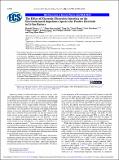The Effect of Electrode-Electrolyte Interface on the Electrochemical Impedance Spectra for Positive Electrode in Li-Ion Battery
Author(s)
Tatara, Ryoichi; Karayaylali, Pinar; Yu, Yang; Zhang, Yirui; Giordano, Livia; Maglia, Filippo; Jung, Roland; Schmidt, Jan Philipp; Lund, Isaac; Shao-Horn, Yang; ... Show more Show less
DownloadJ. Electrochem. Soc.-2019-Tatara-A5090-8.pdf (1.275Mb)
PUBLISHER_CC
Publisher with Creative Commons License
Creative Commons Attribution
Terms of use
Metadata
Show full item recordAbstract
Understanding the effect of electrode-electrolyte interface (EEI) on the kinetics of electrode reaction is critical to design high-energy Li-ion batteries. While electrochemical impedance spectroscopy (EIS) is used widely to examine the kinetics of electrode reaction in Li-ion batteries, ambiguities exist in the physical origin of EIS responses for composite electrodes. In this study, we performed EIS measurement by using a three-electrode cell with a mesh-reference electrode, to avoid the effect of counter electrode impedance and artefactual responses due to asymmetric cell configuration, and composite or oxide-only working electrodes. Here we discuss the detailed assignment of impedance spectra for LiCoO[subscript 2] as a function of voltage. The high-frequency semicircle was assigned to the impedance associated with ion adsorption and desorption at the electrified interface while the low-frequency semicircle was related to the charge transfer impedance associated with desolvation/solvation of lithium ions, and lithium ion intercalation/de-intercalation into/from LixCoO[subscript 2]. Exposure to higher charging voltages and greater hold time at high voltages led to no significant change for the high-frequency component but greater resistance and greater activation energy for the low-frequency circle. The greater charge transfer impedance was attributed to the growth of EEI layers on the charged LixCoO[subscript 2] surface associated with electrolyte oxidation promoted by ethylene carbonate dehydrogenation.
Keywords: Batteries - Lithium, Electrode Kinetics, EIS, Electrode-Electrolyte Interface, Li-ion Batteries
Date issued
2018-11Department
Massachusetts Institute of Technology. Department of Materials Science and Engineering; Massachusetts Institute of Technology. Department of Mechanical Engineering; Massachusetts Institute of Technology. Research Laboratory of ElectronicsJournal
Journal of The Electrochemical Society
Publisher
Electrochemical Society
Citation
Tatara, Ryoichi, Pinar Karayaylali, Yang Yu, Yirui Zhang, Livia Giordano, Filippo Maglia, Roland Jung, Jan Philipp Schmidt, Isaac Lund, and Yang Shao-Horn. “The Effect of Electrode-Electrolyte Interface on the Electrochemical Impedance Spectra for Positive Electrode in Li-Ion Battery.” Journal of The Electrochemical Society 166, no. 3 (November 27, 2018): A5090–A5098.
Version: Final published version
ISSN
0013-4651
1945-7111